Related Research Articles

The Great Western Railway (GWR) was a British railway company that linked London with the southwest, west and West Midlands of England and most of Wales. It was founded in 1833, received its enabling act of Parliament on 31 August 1835 and ran its first trains in 1838 with the initial route completed between London and Bristol in 1841. It was engineered by Isambard Kingdom Brunel, who chose a broad gauge of 7 ft —later slightly widened to 7 ft 1⁄4 in —but, from 1854, a series of amalgamations saw it also operate 4 ft 8+1⁄2 in standard-gauge trains; the last broad-gauge services were operated in 1892.

The London, Midland and Scottish Railway (LMS) was a British railway company. It was formed on 1 January 1923 under the Railways Act 1921, which required the grouping of over 120 separate railways into four. The companies merged into the LMS included the London and North Western Railway, the Midland Railway, the Lancashire and Yorkshire Railway, several Scottish railway companies, and numerous other, smaller ventures.
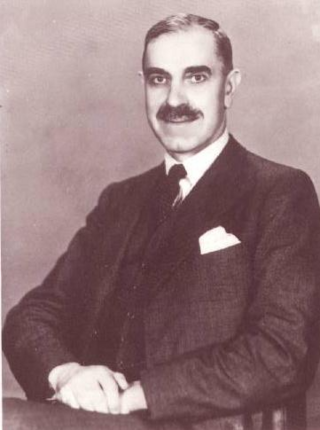
Sir William Arthur Stanier, was a British railway engineer, and was chief mechanical engineer of the London, Midland and Scottish Railway.

Henry George Ivatt, known as George Ivatt, was the post-war Chief Mechanical Engineer of the London Midland and Scottish Railway. He was the son of the Great Northern Railway locomotive engineer Henry Ivatt. George Ivatt was born in Dublin, Ireland, and educated at Uppingham School, England. He married Dorothy Sarah Harrison (1881-1962) in 1913.
George Hughes was an English locomotive engineer, and chief mechanical engineer (CME) of the Lancashire and Yorkshire Railway (L&YR) and the London, Midland and Scottish Railway (LMS).

Henry Alfred Ivatt was an English railway engineer, and was the Chief Mechanical Engineer of the Great Northern Railway from 1896 to 1911.
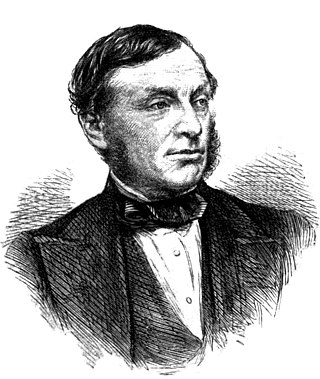
Sir Daniel Gooch, 1st Baronet was an English railway locomotive and transatlantic cable engineer. He was the first Superintendent of Locomotive Engines on the Great Western Railway from 1837 to 1864 and its chairman from 1865 until his death in 1889.
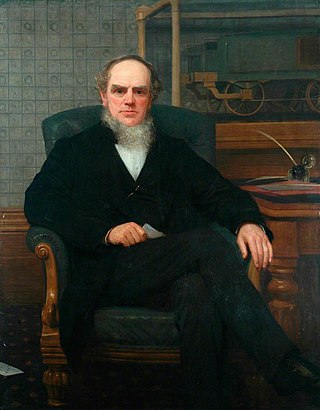
John Ramsbottom was an English mechanical engineer. Born in Todmorden, then on the county border of Yorkshire and Lancashire. He was the Chief Mechanical Engineer for the London and North Western Railway for 14 years. He created many inventions for railways but his main legacy is the split metal piston ring, virtually all reciprocating engines continue to use these today.
William Stroudley was an English railway engineer, and was one of the most famous steam locomotive engineers of the nineteenth century, working principally for the London, Brighton and South Coast Railway (LB&SCR). He designed some of the most famous and longest-lived steam locomotives of his era, several of which have been preserved.

Swindon Works was opened by the Great Western Railway in 1843 in Swindon, Wiltshire, England. It served as the principal west England maintenance centre until closed in 1986.
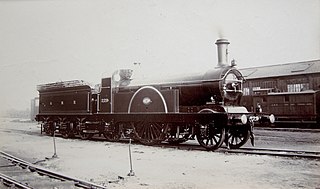
Archibald Sturrock was a Scottish mechanical engineer who was born at Petruchie, Angus, Scotland. He was locomotive superintendent of the Great Northern Railway from 1850 until c. 1866, having from 1840 been Daniel Gooch's assistant on the Great Western Railway.
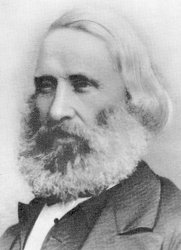
Joseph Armstrong was an English locomotive engineer and the second locomotive superintendent of the Great Western Railway. His younger brother George and one of his sons also became outstanding engineers in the employment of the GWR.

Lieutenant Colonel William Yolland CB, FRS FRSA was an English military surveyor, astronomer and engineer, and was Britain's Chief Inspector of Railways from 1877 until his death. He was a redoubtable campaigner for railway safety, often in the face of strong opposition, at a time when railway investment was being directed towards the expansion of the networks rather than the prevention of accidents. He was a member of the three-man committee of inquiry into the Tay Bridge disaster.
The Stephenson Locomotive Society (SLS) was founded in the UK in Autumn 1909 for the study of rail transport and locomotives. More recently, on 1 January 2017, the SLS became a private company limited by guarantee, registered in England and Wales 10471004.

The Adams axle is a form of radial axle for rail locomotives that enable them to negotiate curves more easily. It was invented by William Bridges Adams and patented in 1865. The invention uses axle boxes that slide on an arc in shaped horn blocks, so allowing the axle to slide out to either side. This is similar to the movement of a Bissell truck, but with the notional centre point of the curve being where the pivot of the truck would be. This design, using slide bearings, is more expensive than one employing a shaft, but takes up less space.
The Over and Wharton branch line was a railway line serving the town of Winsford in Cheshire. It was owned and operated by the London and North Western Railway Company (LNWR) from 1882 and then the London Midland and Scottish Railway (LMS) until the railways were nationalised under the Transport Act 1947, which took effect on 1 January 1948. Thereafter the branch was operated by British Railways London Midland Region until the line's closure in March 1991.
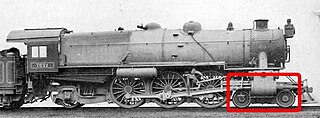
The leading wheel or leading axle or pilot wheel of a steam locomotive is an unpowered wheel or axle located in front of the driving wheels. The axle or axles of the leading wheels are normally located on a leading truck. Leading wheels are used to help the locomotive negotiate curves and to support the front portion of the boiler.
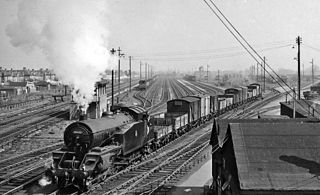
Feltham marshalling yard, also known as Feltham hump yard, was a large railway marshalling yard designed for the concentration of freight traffic to and from South West London, and for transfer to other marshalling yards in London. It was built on the Waterloo to Reading Line. It opened in 1918 and was closed by British Railways on 6 January 1969.
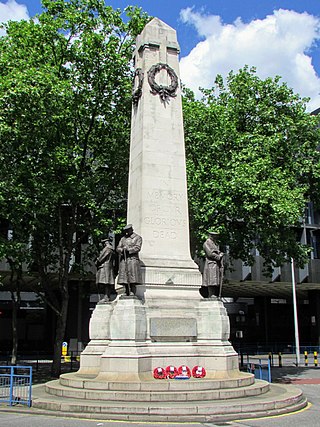
The London and North Western Railway War Memorial is a First World War memorial located outside Euston station in London, England. The memorial was designed by Reginald Wynn Owen, architect to the London and North Western Railway (LNWR), and commemorates employees of the LNWR who were killed in the First World War. Some 37,000 LNWR employees left to fight in the war—around a third of the company's workforce—of whom over 3,000 were killed. As well as personnel, much of the company's infrastructure was turned over to the war effort. Of the £12,500 cost of the memorial, £4,000 was contributed by the employees and the company paid the remainder.
References
- 1 2 Biddle, Gordon (1990). "Chapter 2: Promoting a Railway". The Railway Surveyors: The Story of Railway Property Management 1800-1990. London: Ian Allan Ltd. pp. 27–43. ISBN 0-7110-1954-1.
- 1 2 3 Simmons, Jack (1995). The Victorian Railway (1st Paperback ed.). London: Thames & Hudson Ltd. pp. 102–109. ISBN 978-0-500-28810-8.
- ↑ Simmons, Jack; Biddle, Gordon (1997). The Oxford Companion to British Railway History From 1603 to the 1990s (1st ed.). Oxford: Oxford University Press. p. 225. ISBN 0-19-211697-5.
- 1 2 Hall, Stanley (1990). Railway Detectives: The 150-year Saga of the Railway Inspectorate. London: Ian Allan Ltd. pp. 9–10. ISBN 0-7110-1929-0.
- 1 2 3 Hutter, Bridget M. (1997). Compliance: Regulation and Environment. Oxford Socio-Legal Studies. Oxford: Oxford University Press. p. 49. ISBN 0-19-826475-5.
- ↑ Biddle, Gordon (1990). The Railway Surveyors: The Story of Railway Property Management 1800-1990. London: Ian Allan Ltd. p. 59. ISBN 0-7110-1954-1.
- 1 2 3 4 5 Simmons, Jack (1995). The Victorian Railway (1st Paperback ed.). London: Thames & Hudson Ltd. pp. 112–114. ISBN 978-0-500-28810-8.
- ↑ Simmons, Jack; Biddle, Gordon (1997). The Oxford Companion to British Railway History From 1603 to the 1990s (1st ed.). Oxford: Oxford University Press. pp. 415–416. ISBN 0-19-211697-5.
- ↑ Owen, Roy (1996). Norwegian Railways: from Stephenson to high-speed. Hitchin: Balholm Press. pp. 177–183. ISBN 0-9528069-0-8.
- ↑ Cattell, John; Falconer, Keith (1995). Swindon: The Legacy of a Railway Town. London: (Royal Commission on the Historical Monuments of England) HMSO. pp. 4–5. ISBN 0-11-300053-7.
- ↑ Cattell, John; Falconer, Keith (1995). "Chapter 1: 'Furze, Rushes and Rowen - a greenfield site". Swindon: The Legacy of a Railway Town. London: (Royal Commission on the Historical Monuments of England) HMSO. pp. 1–15. ISBN 0-11-300053-7.
- ↑ Simmons, Jack; Biddle, Gordon (1997). The Oxford Companion to British Railway History From 1603 to the 1990s (1st ed.). Oxford: Oxford University Press. pp. 317–318. ISBN 0-19-211697-5.
- 1 2 3 4 5 6 7 8 9 10 11 Lowe, James W. (1975). British Steam Locomotive Builders. Cambridge: Goose and Son. ISBN 0-900404-21-3.
- ↑ "Oliver Vaughan Snell Bulleid". January 4, 2011. Retrieved September 5, 2011.
- ↑ Marsden, Richard (2011). "Oliver Bulleid". The London & North Eastern Railway (LNER) Encyclopedia. Winwaed Software Technology LLC. Retrieved September 5, 2011.
- 1 2 "Oliver Vaughn Snell Bulleid, CBE 1882–1970". 34058 – Sir Frederick Pile. Archived from the original on January 5, 2009. Retrieved September 5, 2011.
- ↑ Herring, Peter (2004). Yesterday's Railways. David & Herring. p. 172. ISBN 0-7153-1733-4.
- ↑ "George Jackson Churchward". SwindonWeb. Retrieved September 5, 2011.
- ↑ Bryan, Tim (2010). The Great Western Railway. Shire Publications. p. 23. ISBN 978-0-7478-0788-9.